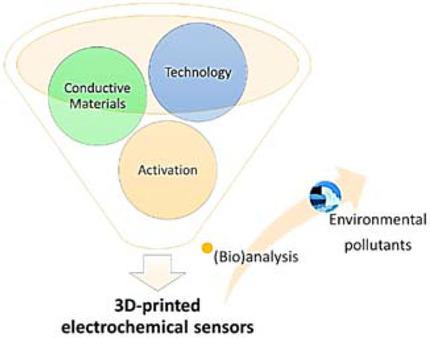当前位置:
X-MOL 学术
›
ChemElectroChem
›
论文详情
Our official English website, www.x-mol.net, welcomes your
feedback! (Note: you will need to create a separate account there.)
Accounts in 3D‐Printed Electrochemical Sensors: Towards Monitoring of Environmental Pollutants
ChemElectroChem ( IF 3.5 ) Pub Date : 2020-07-09 , DOI: 10.1002/celc.202000601 Jose Muñoz, Martin Pumera
ChemElectroChem ( IF 3.5 ) Pub Date : 2020-07-09 , DOI: 10.1002/celc.202000601 Jose Muñoz, Martin Pumera

|
Heavy metal ions, small organic molecules and inorganic pollutants are some environmentally hazardous compounds that negatively impact the ecosystem and public health, owing to their high toxicity, persistency and bioaccumulation. This makes it essential to develop rapid, simple, low‐cost and sensitive devices for in situ monitoring of these toxic contaminants. In this sense, 3D printing is an additive manufacturing technique, which is transforming the way that materials are turned into functional devices by prototyping bespoke 3D materials via layer‐by‐layer deposition. This technology can offer enormous potential to environmental devices, where electrochemical sensing platforms have been on the rise, as they offer decentralized and tailored fabrication of on‐demand, low‐cost, at‐point‐of‐use systems. Although this research is still in an early stage, this Minireview aims to point out the most widely used additive manufacturing technology and materials for 3D‐printed electrode fabrication, as well as some pivotal activation procedural steps necessary to enhance their electroanalytical capabilities. Indeed, the potential of 3D‐printed electrochemical sensors to monitor a range of important hazardous pollutants in aqueous samples is reported, visualizing the future of this technology to develop integrated low‐cost analytical electronic systems for direct environmental detection in remote areas of the globe.
中文翻译:

3D打印电化学传感器的应用:监测环境污染物
重金属离子,有机小分子和无机污染物是一些对环境有害的化合物,由于它们的高毒性,持久性和生物蓄积性,会对生态系统和公众健康产生负面影响。因此,开发用于现场监测这些有毒污染物的快速,简单,低成本和灵敏的设备至关重要。从这个意义上讲,3D打印是一种增材制造技术,通过逐层沉积对定制的3D材料进行原型制作,正在改变将材料转变为功能设备的方式。这项技术可以为电化学传感平台不断发展的环境设备提供巨大潜力,因为它们可以按需,低成本,按需使用系统进行分散和量身定制的制造。尽管这项研究仍处于早期阶段,但本Minireview的目的是指出用于3D打印电极制造的最广泛使用的增材制造技术和材料,以及增强其电分析能力所必需的一些关键活化程序步骤。确实,据报道,使用3D打印的电化学传感器监测水性样品中一系列重要有害污染物的潜力,使该技术的未来发展成为可能,以开发集成的低成本分析电子系统以在全球偏远地区进行直接环境检测。以及增强其电分析能力所必需的一些关键激活程序步骤。确实,据报道,使用3D打印的电化学传感器监测水性样品中一系列重要有害污染物的潜力,使该技术的未来发展成为可能,以开发集成的低成本分析电子系统以在全球偏远地区进行直接环境检测。以及增强其电分析能力所必需的一些关键激活程序步骤。实际上,已经报道了3D打印的电化学传感器监测水性样品中一系列重要有害污染物的潜力,使该技术的未来发展成为可能,从而开发出集成的低成本分析电子系统,可在全球偏远地区进行直接环境检测。
更新日期:2020-08-17
中文翻译:

3D打印电化学传感器的应用:监测环境污染物
重金属离子,有机小分子和无机污染物是一些对环境有害的化合物,由于它们的高毒性,持久性和生物蓄积性,会对生态系统和公众健康产生负面影响。因此,开发用于现场监测这些有毒污染物的快速,简单,低成本和灵敏的设备至关重要。从这个意义上讲,3D打印是一种增材制造技术,通过逐层沉积对定制的3D材料进行原型制作,正在改变将材料转变为功能设备的方式。这项技术可以为电化学传感平台不断发展的环境设备提供巨大潜力,因为它们可以按需,低成本,按需使用系统进行分散和量身定制的制造。尽管这项研究仍处于早期阶段,但本Minireview的目的是指出用于3D打印电极制造的最广泛使用的增材制造技术和材料,以及增强其电分析能力所必需的一些关键活化程序步骤。确实,据报道,使用3D打印的电化学传感器监测水性样品中一系列重要有害污染物的潜力,使该技术的未来发展成为可能,以开发集成的低成本分析电子系统以在全球偏远地区进行直接环境检测。以及增强其电分析能力所必需的一些关键激活程序步骤。确实,据报道,使用3D打印的电化学传感器监测水性样品中一系列重要有害污染物的潜力,使该技术的未来发展成为可能,以开发集成的低成本分析电子系统以在全球偏远地区进行直接环境检测。以及增强其电分析能力所必需的一些关键激活程序步骤。实际上,已经报道了3D打印的电化学传感器监测水性样品中一系列重要有害污染物的潜力,使该技术的未来发展成为可能,从而开发出集成的低成本分析电子系统,可在全球偏远地区进行直接环境检测。











































 京公网安备 11010802027423号
京公网安备 11010802027423号